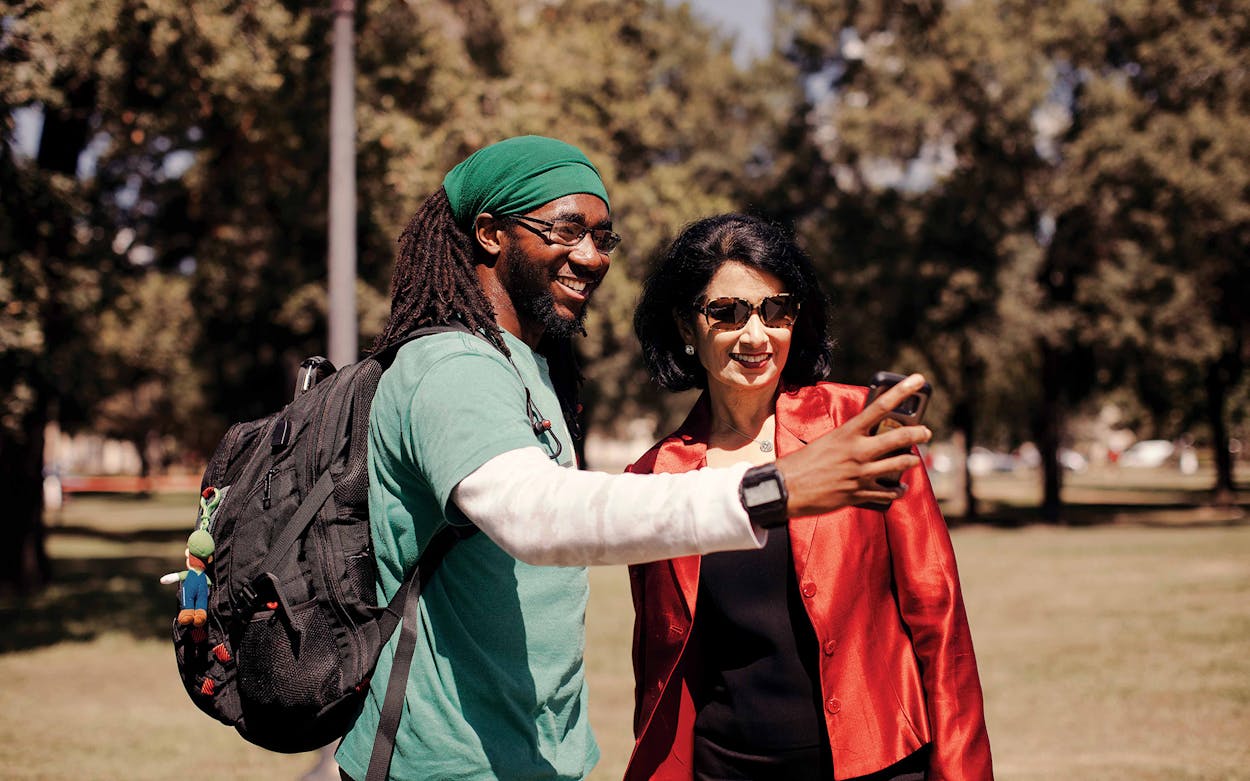Apart from its early-eighties Phi Slama Jama men’s basketball team and a top-ranked creative writing program, the University of Houston has largely stayed under the national radar as a solid if unexciting commuter school since its founding, in 1927, as Houston Junior College.
The city’s largest public university in the country’s fourth-largest city finally asserted itself in 2008, when Renu Khator was hired as the university president and chancellor of the University of Houston System. Khator, who was born and raised in the Indian state of Uttar Pradesh, immigrated to the United States in 1974, earning her PhD in political science and public administration at Purdue University before being hired as a professor by the University of South Florida, where, over the next two decades, she worked her way up to provost before being tapped for the top job at UH.
In Houston, Khator immediately set about transforming a school derisively called Cougar High into an academic and athletic powerhouse. To revive campus life, she added several new residence halls, spent $80 million expanding the student center, erected a new football stadium, and renovated the basketball arena. Khator’s relentless fundraising (the university is nearing the end of a $1 billion capital campaign) and faculty recruiting bore fruit in 2011, when UH became the fourth university in Texas to earn Tier One status from the Carnegie Foundation, putting it in the company of Rice and UT-Austin. In 2015 the university was awarded a coveted Phi Beta Kappa chapter.
But Khator’s work is far from done. U.S. News & World Report ranks UH a mediocre 171 among 312 national research universities, in part because only 54 percent of students graduate in six years—ten points higher than when Khator arrived but still six points below the national average. Her efforts to improve graduation rates while juggling dozens of other tasks—most prominently, her plan to open a new medical school—make Khator one of the hardest-working university presidents in the country. To see how she keeps so many balls in the air, Texas Monthly tagged along with her during a typical workday.
Thursday, October 4, 2018
8:03 a.m. At the Waldorf Astoria Ballroom of the Hilton University of Houston, Khator, wearing a satiny red blazer adorned with a sparkling UH lapel pin, brings to order the fall meeting of the Board of Visitors, a group of 61 high-profile alumni and friends of the university that includes UH basketball great Elvin Hayes and the usual assortment of bank and insurance company presidents. Khator begins the meeting by screening a new promo spot for the university, which will air during this evening’s nationally televised football game against the University of Tulsa. The thirty-second ad features soaring views of the UH campus and a voice-over by Indonesian-born undergraduate Muhammad Khaerisman, an actor and slam poet.
“Wow,” Khator says when it’s over. “Can we watch that again?”
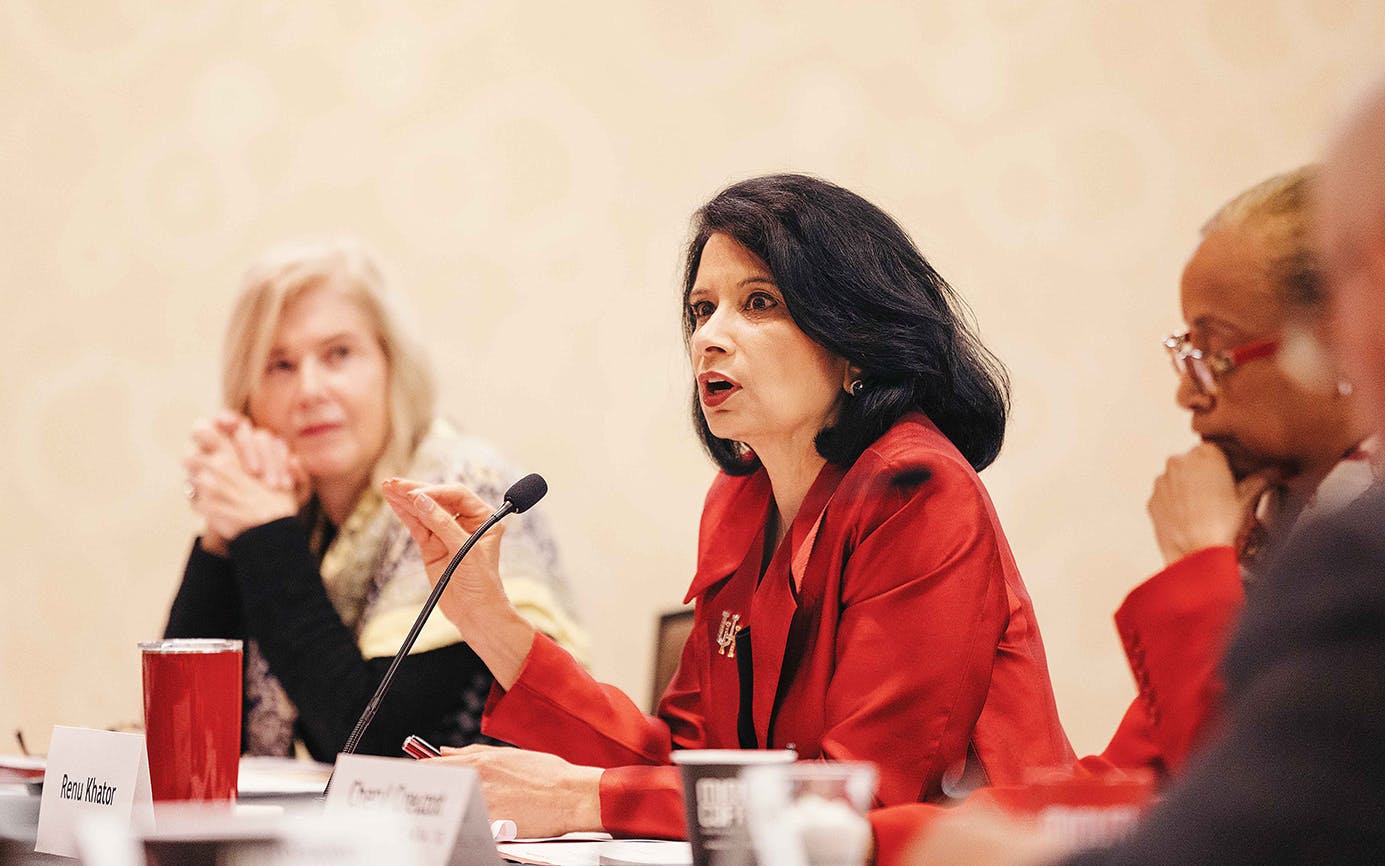
9:56 a.m. Meeting adjourned, Khator climbs into the back seat of a Volvo SUV for the short drive to city hall in downtown Houston, where she has a meeting with Mayor Sylvester Turner to discuss progress on the proposed school of medicine.
10:35 a.m. In Turner’s wood-paneled office, Khator, the mayor, and a group of UH lobbyists discuss the strategy for getting accreditation for the medical school. Speaking without notes, Khator discusses funding and potential building sites. “We want to give you all the ammunition you need to support the school,” she tells Turner.
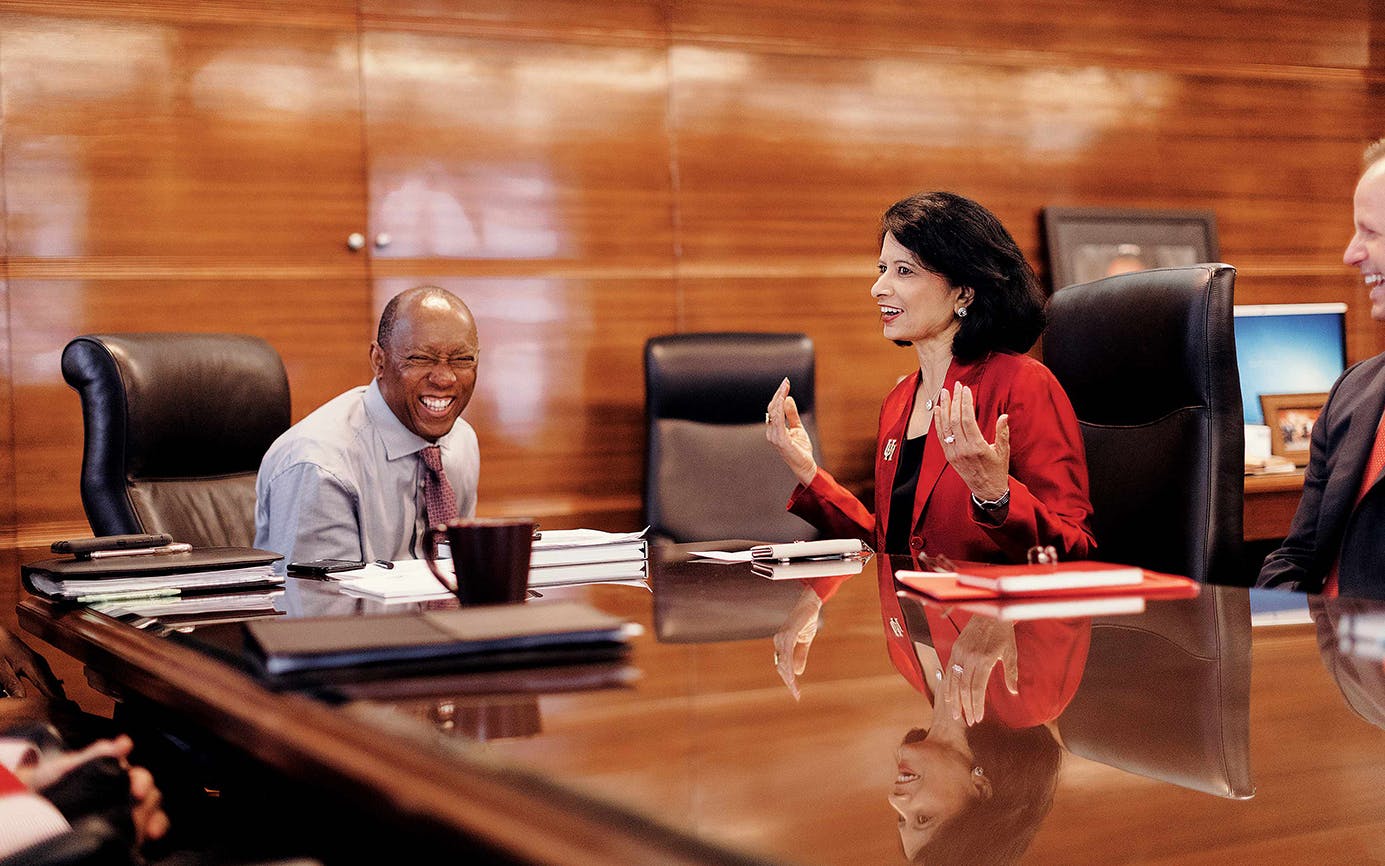
11:04 a.m. On her way out of city hall, Khator whips out her smartphone to Instagram a photo of herself and the mayor that her communications director, Mike Rosen, took a few minutes earlier. Khator maintains a robust social media presence: she has more than 90,000 Twitter followers—the second most of any college president, according to her staff, after West Virginia University’s E. Gordon Gee—and takes pride in writing her own posts. She boasts that her communications team doesn’t have any of her passwords.
12:09 p.m. Back on campus, Khator walks into Moody Towers Dining Commons for lunch, where she often dines with students, and spots a student wearing a University of Texas T-shirt—on a football game day, no less—and feigns indignation. When Khator first arrived at UH, she noticed few people on campus wearing university apparel. To boost school pride, she began encouraging students, faculty, and staff to wear red every Friday. “My whole closet is red,” she jokes, a slight exaggeration that is easily confirmed by scrolling through her Instagram feed. A member of Khator’s staff hands the student a card redeemable for a free UH T-shirt.

12:52 p.m. “Ms Renu! Ms Renu!” students shout as she walks back to her office after lunch. Everywhere Khator goes on campus, she’s treated like a rock star. Students grin, say hello, inquire about the stray dog Khator recently adopted (a star of her Twitter feed), and, inevitably, request a selfie. Khator always obliges.
1:01 p.m. Sitting behind a carved wooden desk in her spacious office on the second floor of the art deco–style Ezekiel W. Cullen Building, Khator takes a phone call from Michael Aresco, the commissioner of the American Athletic Conference, whose board of directors she chairs. They have a brief conversation about bowl games and scheduling. Khator’s parquet-floored office is stuffed with Cougar athletic memorabilia, Indian handicrafts, and dozens of photos of her with world leaders, including four U.S. presidents, two Indian prime ministers, one Supreme Court justice, and Beyoncé.
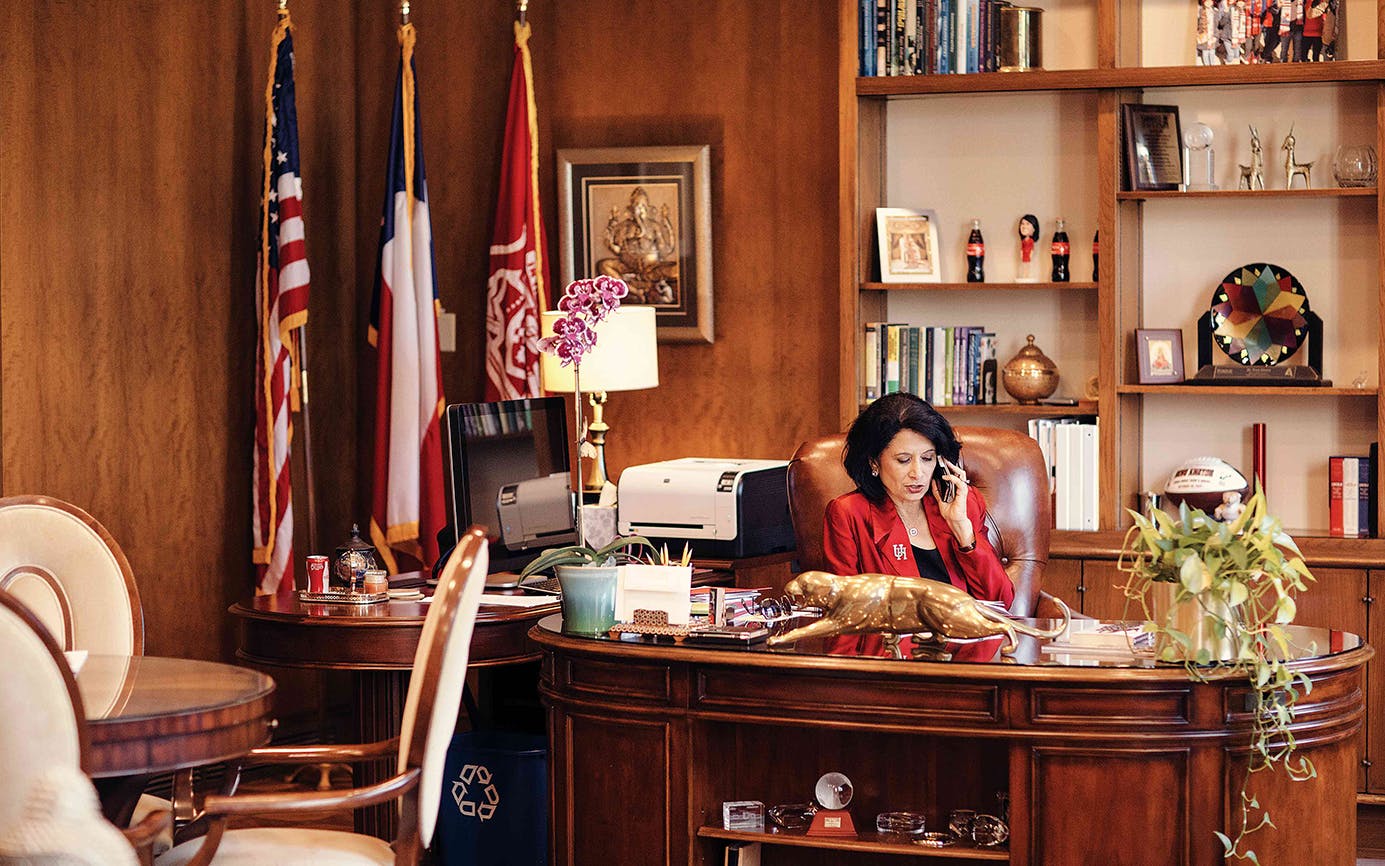
1:29 p.m. Egyptian-born engineer Amr Elnashai, UH’s vice president for research and technology transfer, and Tom Campbell, executive director of intellectual property management, arrive in Khator’s office to give her a progress update on the university’s 74-acre Technology Bridge center, which commercializes faculty research on energy. Khator asks Elnashai and Campbell for their opinions on the section of her upcoming fall address dedicated to the center’s 30,000-square-foot start-up incubator. After listening to their advice, Khator agrees to add a sentence or two to her remarks.
2:32 p.m. Khator delivers a short talk to an Honors College freshman seminar in which she urges the seventeen students to branch out beyond their existing social networks. “That means exposing yourself to ideas that you may disagree with and that may even offend you,” she says. “You have to push yourself out of your comfort zone.”

4:25 p.m. Back in her office, Khator meets with Stephen Spann, dean of the future medical school, who updates her on fundraising, faculty hiring, and the timeline for accreditation. “What is the climate of opinion about the medical school right now?” Khator asks. “People are excited about it,” Spann replies. “Everywhere I go, people say they want to come work here.”
5:09 p.m. Khator and Spann head to a nearby conference room to host a wine and cheese reception for about a dozen medical school professors and administrators. Khator tells the group about her recent trip to New Delhi, where she gave a talk about women’s rights, as she often does. Khator is a much-sought-after speaker, both in the U.S. and in her native country. “I always ask the organizers, ‘Is this speech for women only or also for men?’ ” Khator says. “Because I think they both need to hear it.”
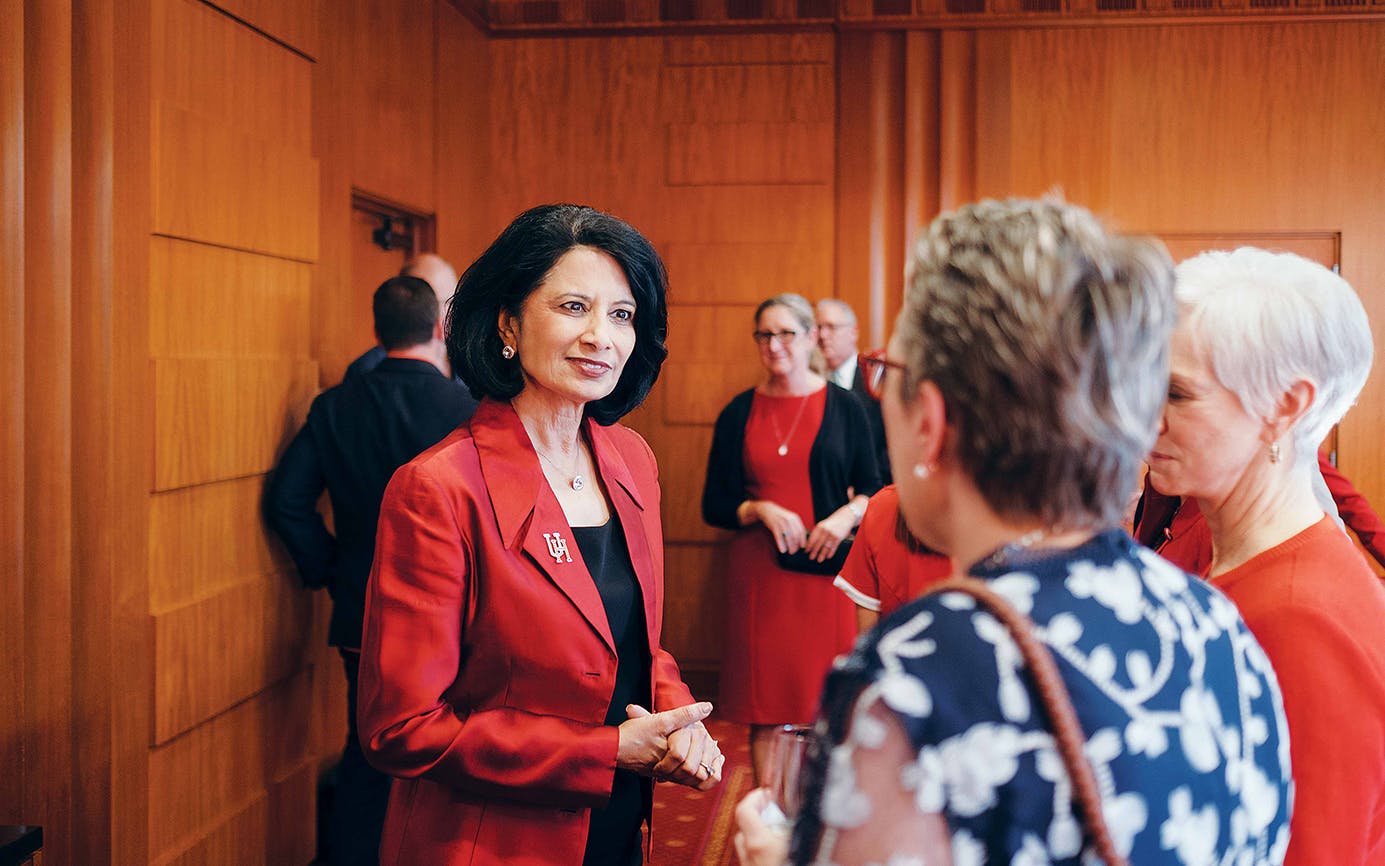
6:14 p.m. Khator’s driver drops her off in front of the four-year-old TDECU Stadium, where her husband, Suresh, a professor of industrial engineering at UH, is waiting. The president has changed into a replica UH football jersey with her name emblazoned across the back. American football attracts little interest in India, but Renu and Suresh have become enthusiastic devotees, attending nearly every game, home or away. “I’m always nervous before a game,” Khator confides. Last year, Tulsa humiliated Houston 45–17 in Oklahoma; this year, the Cougars are bent on revenge. “It all depends on our defense,” Khator explains. “All of our players must show up today.”
Accompanied by a security guard, Renu and Suresh walk over to the rowdy student tailgate, where they are immediately recognized and mobbed by the red-and-white faithful. Frat brothers and sorority sisters, jocks and nerds, the inebriated and the sober—everyone wants a selfie with the chancellor or her famous-by-association husband. The two happily pose for shot after shot, flashing the Cougar hand sign (index, middle, and pinkie fingers raised), as trap music blares from the hospitality tents.
6:55 p.m. Khator finally extricates herself from the crowd and slips into the stadium, taking an elevator to the Chancellor’s Suite, a commodious private box perched above the 40-yard line, well stocked with food, liquor, and big-money donors. After the requisite schmoozing, Renu and Suresh excuse themselves and walk through a glass door to the suite’s two rows of seats. They sit down by themselves, in the back row, just in time for the game’s opening kickoff.
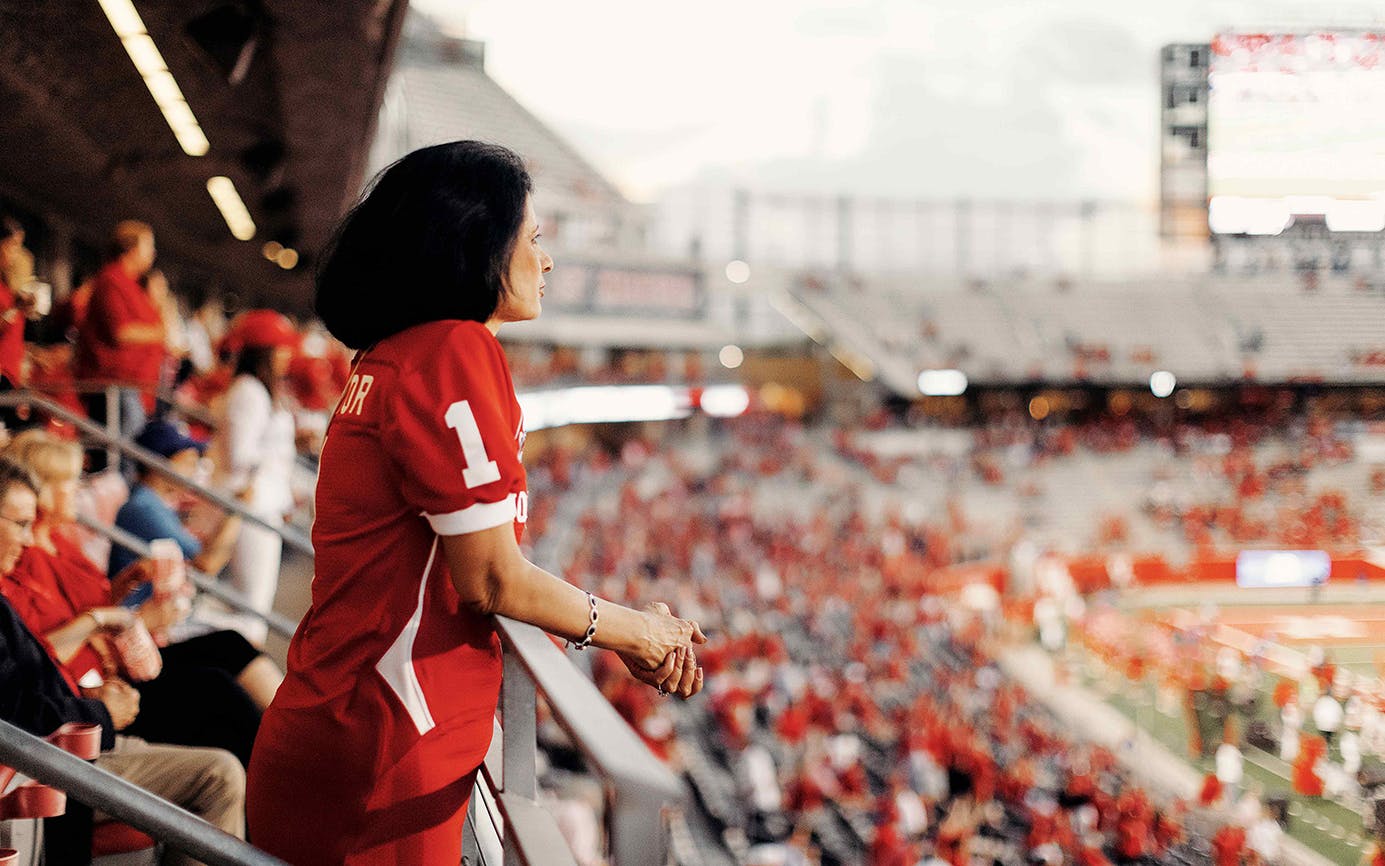
10:44 p.m. In her final social media post of the day, Khator triumphantly tweets the final score: UH 41, Tulsa 26. “Last 10 minutes did the magic!”
This article originally appeared in the December 2018 issue of Texas Monthly with the headline “Working Nonstop to Turn a Commuter School Into a World-class University.” Subscribe today.


